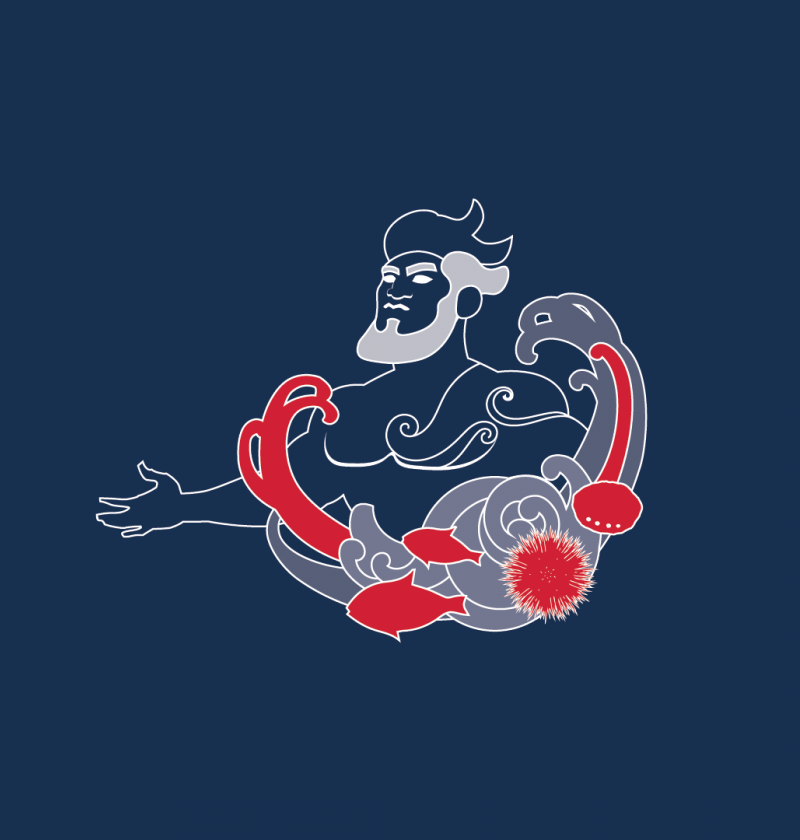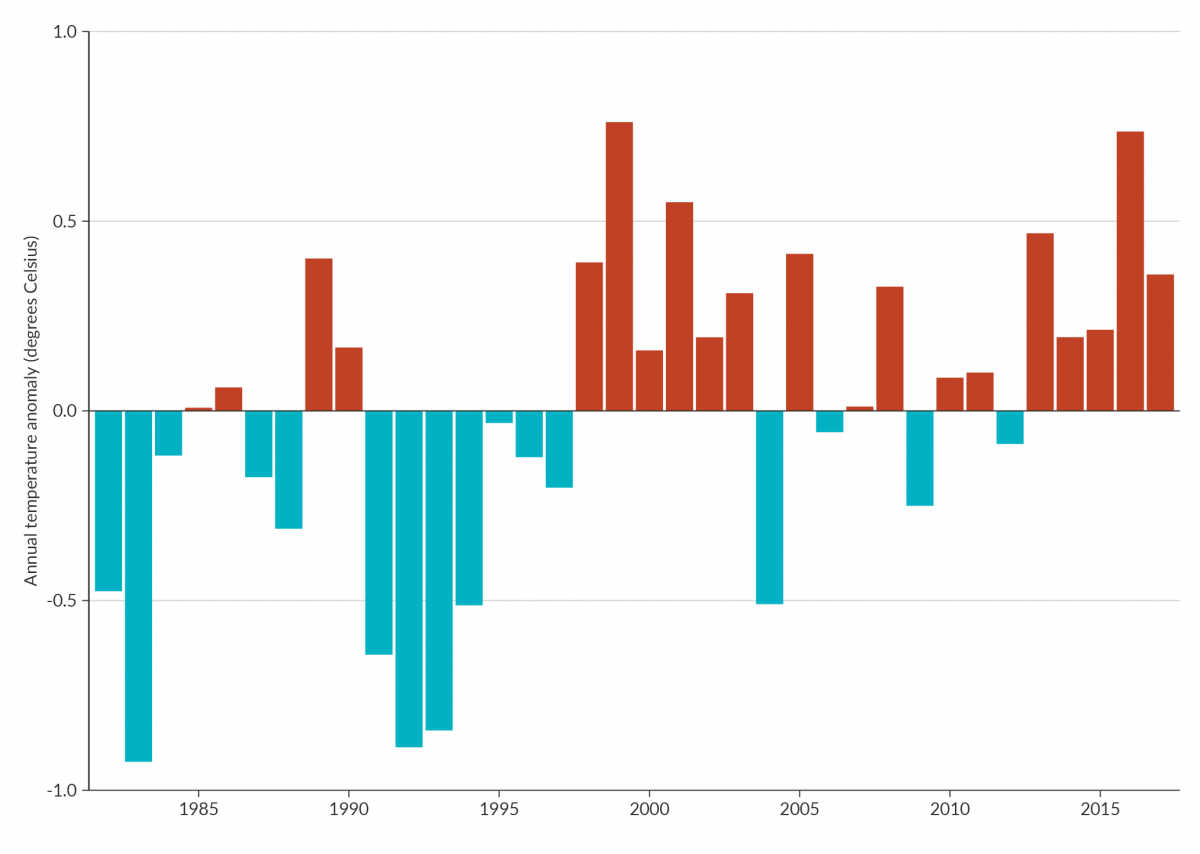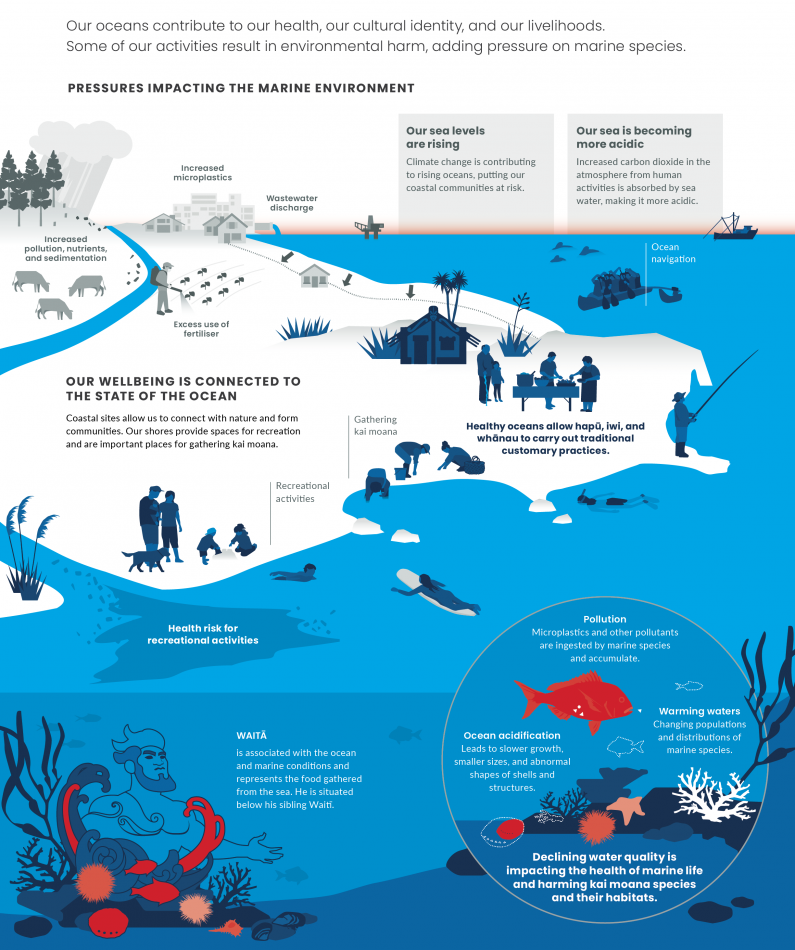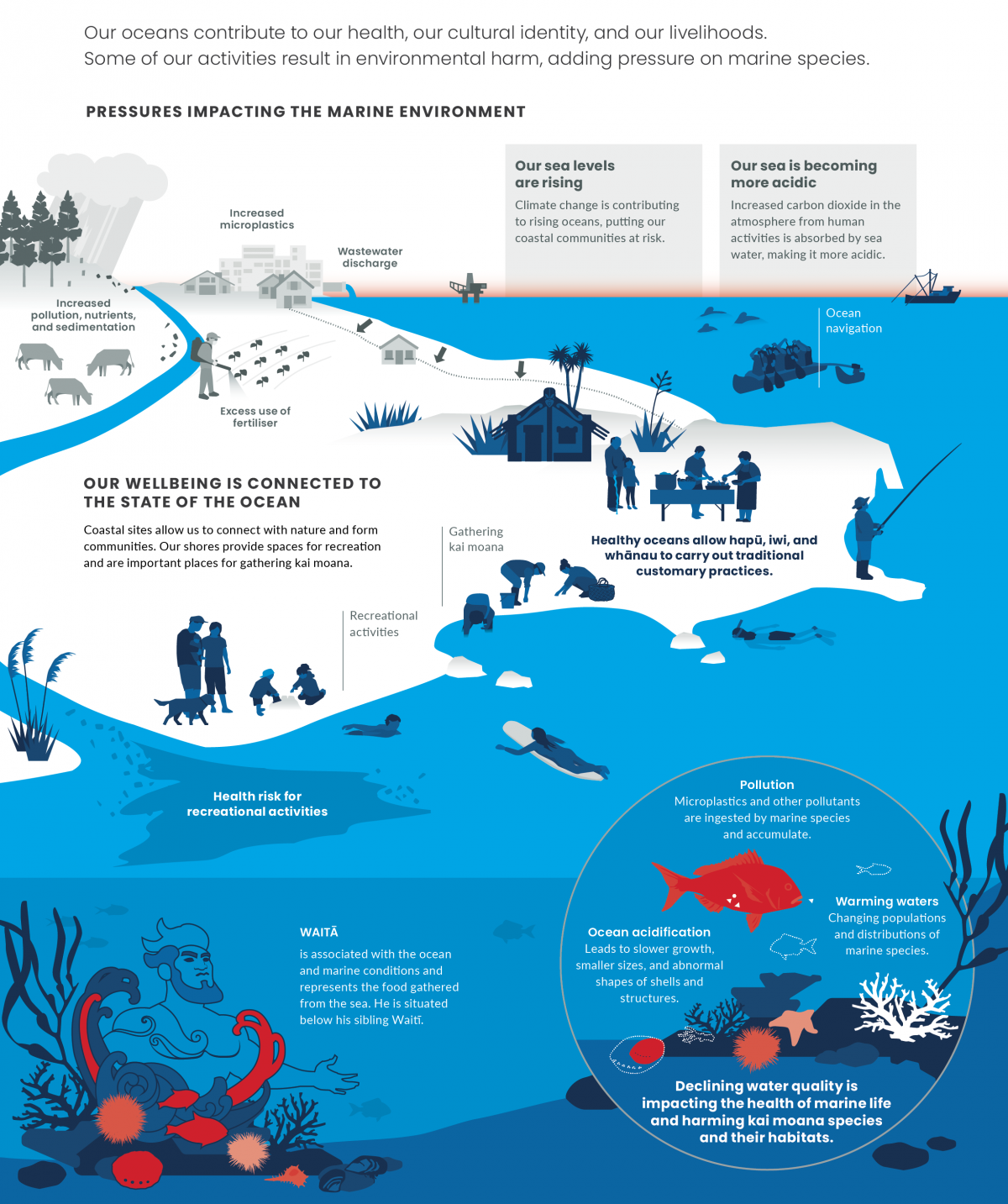Waitā Ocean and marine conditions

E tū Waitā e
Te tai tamatāne
Te tai tamawahine
Te tini a Tangaroa
Behold Waitā
From the west coast
To the east coast
The bounty of the ocean
Waitā (Taygeta) is associated with the ocean and marine conditions and represents the many types of food gathered from the sea. Waitā is comprised of two words, wai (water) and tā (salt). Waitā is linked to three atua: Kiwa, controller of the ocean; Hinemoana, the mother of all marine sentient beings; and Tangaroa, the great atua of the ocean (Best, 2005; Matamua, 2017).
This section is about the ways we depend on the ocean for our livelihoods and wellbeing, and how these are being affected by pollution, climate change, and resource depletion.
For many Māori, the ability to gather seafood (kai moana) is an important indicator of the mauri of the ocean and is reflected in the extent to which traditional food gathering practices (mahinga kai) can be carried out (see the Matariki section for the definition of mauri used in this report). This in turn is linked to other aspects of life and tikanga Māori (customs/protocols).
These include manaakitanga, the ability to host guests (manuhiri) at marae, and oranga, sustaining the health and welfare of whānau. Many iwi have a system of pātaka, where kai moana are collected and distributed to iwi members for cultural purposes.
If our marine environment is unhealthy, traditional kai moana species are put at risk. Their disappearance, whether localised or across the country, can also mean the loss of Māori knowledge (mātauranga Māori) and traditional practices relating to these species and their collection. Mana moana, which includes the inherent right of iwi to harvest kai moana within their rohe (region), is unable to be exercised, and customary practices of harvesting at specific times of the seasons and maramataka fall out of use (see Tupuānuku section).
There are specific kai moana species found in each region that have significant cultural value to the iwi in those regions. If these species are not available – if their populations are reduced due to pollution or overfishing – this affects the mauri of the people and community.
Some species, such as pāua, are having to be translocated to new areas to help their survival (Fisheries New Zealand, 2021). However, translocation can affect local harvesting traditions and practices. If pāua are not available to be caught, passing on knowledge around this taonga (treasured) species becomes more difficult. It can also impact on the mauri of the mahinga kai system, as ecosystems are put out of balance by moving pāua from areas they would naturally live.
Gathering kai moana is an important activity for many New Zealanders. A national survey estimated that nearly 600,000 adult New Zealanders participated in recreational marine fishing between October 2011 and September 2012 (Wynne-Jones et al, 2014). As well as connecting us to our environment, international research has found that people who partake in recreational fishing report experiencing a range of important wellbeing benefits including social support and reductions in stress and anxiety (McManus et al, 2011).
Kina are an important species for many iwi (Kawe, 2014). Historically, their numbers are controlled naturally by predators such as snapper and crayfish. As these predators grow larger, they eat more kina, but also become bigger targets for fishing. Fishing, combined with warmer sea temperatures and the effects of other human activities, has allowed kina numbers to explode in some places. This creates large areas knows as ‘kina barrens,’ where the kina graze all the seaweed and leave behind a bare reef where other species cannot establish (Gee, 2021; Heeringa, 2021). This removes the habitat for many kai moana species, and puts at risk the knowledge and practices associated with them. Kina growing in kina barrens are also of lower quality for food production (Warren-Meyers et al, 2020).
Beaches have a key place in Aotearoa national identity and are central to our leisure culture. Most major population centres are coastal, and beaches are popular holiday destinations. There are many physical, social, and psychological benefits to ocean recreation. People and families form deep attachments to particular coastal sites, and they are key places for connecting with nature and forming communities.
Recreational activities create strong bonds between people and the coastal places they visit, as well as providing stress relief and promoting mental and physical wellbeing. The strength of this connection was made evident during the lockdowns imposed as part of the COVID-19 pandemic response in 2020, when surfing was not allowed. Many surfers vented frustration, anxiety, and anger due to being unable to take part in a practice they saw as central to their identity and wellbeing (Wheaton et al, 2021).
Ocean recreational activities can also revive and maintain cultural practices, in addition to other wellbeing benefits. Waka ama, the sport of paddling traditional Polynesian outrigger canoes, has been growing rapidly in popularity in Aotearoa (Sport New Zealand – Ihi Aotearoa, nd). Waka ama encourages the revitalisation of te reo Māori (Māori language) through the use of karakia (incantations), waiata (song), and general terms used when paddling. Those who engage with this sport also connect with the natural environment, build community, and gain knowledge of waiora, the spiritual connections between health (hauora) and the environment.
Our ability to interact with the ocean through recreational activities is an indicator of its mauri. We get important wellbeing benefits from being able to swim and surf at the beach, kayak in an estuary, or gather shellfish along the coast. If the water is too polluted to do these activities safely, its mauri is degraded, and so too is the mauri of the communities who engage with it.
Water pollution is monitored through measurements of faecal indicator bacteria at many beaches and estuaries around the country. This monitoring indicates the presence of pathogens that can cause gastrointestinal illnesses and other infections, making water unsafe for swimming. These bacteria enter the water from animal excrement, stock effluent, wastewater discharge, and contaminated soil run-off (LAWA, 2021).
We rely on the ocean (moana) to support the economy and provide jobs for people. Data for the year ended March 2017 show that around 33,000 people were employed in the marine economy in Aotearoa. The same data show that the total direct contribution of the marine economy to Aotearoa was $3.8 billion, equating to 1.4 percent of total GDP. Combined with a further $3.2 billion in indirect contributions, the total value of the marine economy in 2017 was $7 billion. Most of this comes through shipping, fishing and aquaculture, and mineral extraction. These economic valuations do not reflect the non-monetary value of the oceans, or account for the environmental harms that some of these activities contribute to. (See indicator: Marine economy.)
Māori are heavily involved in the marine economy, particularly the fishing sector. Māori own around 20 percent of the Aotearoa fishing quota by value, and are actively engaged in all different parts of the fishing industry. A survey of people involved in Māori fishing businesses found that maintaining the mauri of the ocean was equally as important as making a profit and that a majority saw mātauranga Māori as extremely important. However, a similar majority rated the ability for Māori to exercise kaitiakitanga (guardianship) as limited (Reid et al, 2018).
The quality of our coastal waters and marine environment is affected in different ways by human activities on land. Pollution and sediment flowing from rivers into estuaries and coastal waters reduces water quality in the coastal zone, which harms populations of kai moana species and the ecosystems they depend on. Water quality is usually worse in places with higher freshwater inflows. Estuaries generally have worse water quality than the open coast, and are more polluted where there is higher urban or agricultural land cover upstream (Dudley et al, 2020). The processes that affect freshwater and marine domains are closely linked (see Waitī section for detail on freshwater quality).
Rising sea levels also affect the land, increasing coastal erosion which affects coastal communities, damages cultural sites and infrastructure such as bridges and roads, and contributes to the loss of habitats and ecosystems (MfE & Stats NZ, 2019).
The amount of sediment entering the ocean from rivers has increased over decades, particularly in the North Island. The main reason for this is deforestation, as forest cover lowers erosion rates (see Pōhutukawa section for more detail). Before European drainage works and confinement of rivers between stopbanks, floodplains and wetlands would also have intercepted greater proportions of river sediment before it reached the ocean (NIWA, 2019).
The amount of sediment is highly variable by region, and depends on soil type, slope, climate, land cover, and activities within the catchment (Phillips et al, 2017). The New Zealand empirical erosion model estimated that the highest levels of sediment movement into waterways for the North Island was in the Gisborne region (40 million tonnes/year), and for the South Island, in the West Coast region (49 million tonnes/year). (See indicator: Estimated long-term soil erosion). Environment Aotearoa 2019 noted, that in Gisborne, due to a combination of a lack of woody vegetation, steep slopes, and erodible rock types, soil erosion rates are high. On the west coast of the South Island, the highest sediment loads occur in South Westland due to the area’s steep slopes, geology, and heavy rainfall. Sediment accumulation is increasing in many estuaries across Aotearoa, but the rates are highly variable between locations making comparisons difficult (MfE & Stats NZ, 2019).
Increased sediment in estuaries and along coasts directly affects the health of many species (Lowe et al, 2015; Booth 2020; PMCSA, 2021b). For example, cockles, pipi, and scallops feed by filtering food from the water. High sediment loads clog their gills and mean they cannot feed efficiently. Increased sediment can also be harmful for the larval and juvenile life stages of some fish species by reducing available nursery grounds and changing fish gill structure (PMCSA, 2021b).
Increased nutrients such as nitrogen and phosphorus can also reduce water quality in the coastal zone, potentially harming ecosystems that support our kai moana species. International research has shown that nutrients can increase the growth of some organisms and lead to algal blooms. This has a number of flow-on effects, including reducing biodiversity, amenity value, and potential for recreational activities (Larned et al, 2018; Dudley et al, 2020; Plew et al, 2020).
While these nutrients do occur naturally, levels have increased dramatically over time. Compared to modelled natural baseline levels, between 1977 and 2013, human influence led to an estimated 74 percent increase in total nitrogen loads into the ocean, 159 percent increase in nitrate-nitrogen loads, 48 percent increase in total phosphorus, and 18 percent increase in dissolved reactive phosphorus (Snelder et al, 2018).
High nutrient levels in estuaries or the sea can be toxic, or lead to algal blooms which can kill marine life by depleting oxygen levels. Estuaries, particularly those that are shallow or have large intertidal areas, are sensitive to nutrient pollution. Modelling estimates show that more than a quarter of estuaries in Aotearoa are highly or very highly susceptible to ecosystem harm resulting from an excess of nutrients (Plew et al, 2018).
Between 2008 and 2017, 72 percent of coastal and estuarine water quality monitoring sites showed an improving trend for total phosphorus. However, 35 percent of sites showed a worsening trend for total nitrogen over this period while only 18 percent showed an improvement. Across nine of 12 marine water quality variables measured, more sites showed an improving trend than a worsening trend. (See indicator: Coastal and estuarine water quality for details about the variables and trend assessment.) However, across the 12 variables, the trend direction could not be determined for between 25 and 64 percent of sites. Trends also vary by region and are affected by many factors including the complexity of the coastal environment, limited data, and insufficient information about freshwater inputs. (See indicator: Coastal and estuarine water quality.) For more detail see Our marine Environment 2019.
Plastic pollution in the ocean is an enormous problem globally. It is estimated that up to four million tonnes of plastic waste are washed into the oceans globally every year (Schmidt et al, 2017). Microplastics are pieces of plastic less than 5 mm long. They have large negative impacts on marine life and potentially have consequences for human health. Microplastics are widespread throughout the world’s oceans, including in Aotearoa, where they have been found on the seafloor (Fisheries New Zealand, 2020; NIWA, 2021b).
Studies of sampled Aotearoa fish species have found they are commonly ingesting microplastics. Almost a quarter of samples from six species in the Hauraki Gulf had microplastics in their gut, as did 95 percent of hoki samples from the West Coast, Cook Strait, and the Chatham Rise. The studies also found that microplastic fragments can find their way from the gut into fish muscle tissue, potentially passing on the plastic to larger fish and humans who consume it (NIWA, 2021a).
Climate change is having profound effects on our oceans, and reversing many of these changes will take thousands of years even if carbon emissions are reduced. Increased carbon dioxide in the atmosphere from the burning of fossil fuels is absorbed by seawater and makes it more acidic. Ocean acidity increased 7.1 percent between 2008 and 2017 at the monitoring site off the Otago coast which provides data for the longest-running record of ocean acidification in the Southern Hemisphere. (See indicator: Ocean acidification.) This rate of increase is similar to estimates for the world ocean, and ocean acidification is projected to accelerate in Aotearoa and global waters (Law et al, 2018a; Turley et al, 2006).
Sea-surface temperatures are rising due to climate change. On average, coastal waters have warmed by 0.2 degrees Celsius per decade between 1981 and 2018 (see figure 6 and indicator: Sea-surface temperature). Marine heatwaves are also becoming more common (MfE & Stats NZ, 2019).
These changes are affecting our ability to gather kai moana. Evidence suggests marine species will be affected by climate associated change, though quantifying these effects is difficult, due to a lack of data around both species responses and the challenges they may face (Cummings et al, 2021). Ocean acidification impacts key species in several ways. Higher acidity means that pāua larvae cannot establish themselves easily, and can suffer other negative effects including slower growth, lower survival rates, smaller sizes, and abnormal shapes. Some of these effects are also seen in oysters, sea urchins, and corals (Espinel-Velasco et al, 2021). Acidification also means shellfish cannot grow their shells properly, as the calcium in the shells dissolves more easily in more acidic waters (Law et al, 2018a).

Image: Data source — NIWA

Image: Data source — NIWA
Of the fish stocks that are assessed under the Aotearoa quota management system for fisheries, 82 percent are considered to be in good condition in 2020 (MPI, 2020). This means the species can maintain itself while supporting a fishery. However, there are many fish stocks that are not assessed, representing 32 percent of catch (MfE & Stats NZ, 2019). Others are assessed infrequently. Fish stocks and the way we get an indication of seafood stocks aren’t based on observations of local whānau who rely on these food sources for mahinga kai and manaakitanga. This leads to significant knowledge gaps in the assessment process, making the sustainability of fishing levels impossible to gauge (PMCSA, 2021).
Shellfish are important economically, and as recreational and kai moana species. Pāua are highly valued as a food source and play an important role for some Māori in caring for visitors (manaakitanga) (MPI, nd). Pāua management is divided into 11 areas, with different regulations depending on stock levels. Stocks are estimated to be good in the lower North Island and Canterbury areas, while in the upper South Island and Marlborough Sounds stocks have declined and are at risk. In the rest of the North Island, the west coast of the South Island, and the Chatham, Kermadec, and Subantarctic Islands, data are either unavailable, outdated or of poor quality (MPI, 2021b).
There are gaps in knowledge about stock levels for other important species. Green-lipped mussels (kuku) are distributed mainly in the central and northern parts of the country. They are the main mussel species harvested in Aotearoa, with the fishery valued at over $200 million in 2009 (Alfaro et al, 2011). They have been used extensively by Māori and are very important in customary fishing. Despite this, there are currently no stock assessments available. Localised assessments in Ōhiwa Harbour indicate a reduction of more than 99 percent in abundance between 2006 and 2015 due to sediment deposition (MPI, 2021c).
Once populations of shellfish have been depleted, they can take a long time to recover. Toheroa are a native surf clam considered a seafood delicacy. Populations were greatly reduced due to over-harvesting, and commercial and recreational fishing were banned by 1969 and 1980 respectively. Despite having protections in place for over 40 years, toheroa populations have not recovered, and some continue to decline. There are several factors behind this, including widespread illegal harvesting, driving vehicles on beaches, declines in water quality, and a lack of freshwater coming onto beaches from inland (Ross et al, 2018).
Fishing can have long-term and wide-ranging effects on the marine environment beyond depletion of target species. Seabed trawling is a fishing practice that damages the seabed and its habitats. Even after trawling stops, ecosystems can remain damaged and show few signs of recovery for long periods of time (Clark et al, 2019). Seabed trawling is more prevalent in shallow waters, with varying impacts depending on fishing intensity, gear type, and vulnerability of habitat (MfE & Stats NZ, 2019).
The incidental capture of seabirds and marine mammals is another consequence of fishing activity. Incidental captures are still a significant pressure on some populations (MfE & Stats NZ, 2019). Overall, the full ecological impact of fisheries remains a gap in our understanding (MfE & Stats NZ, 2019).
Assessments of fish stocks are done in isolation and do not account for the interactions between different stocks or interactions with the broader marine environment (MfE & Stats NZ, 2019). Marine management approaches and tools based on mātauranga Māori take a more holistic view of the environment, taking into account the health of ecosystems and the wellbeing of communities who are linked to them. Some Māori fishing companies use kaitiaki-based business models and mātauranga Māori to ensure the Māori marine economy is both profitable and sustainable over the long-term (Rout et al, 2019).
Mātaitai reserves are marine management tools which allow Māori to develop localised management regimes for traditional fishing areas. They generally allow for customary and recreational fishing but prohibit commercial fishing (Paul-Burke, 2020). Legislation empowers tangata whenua to establish fishing bylaws to restrict any activities that they consider will threaten the sustainability of the fisheries in a reserve, subject to consultation and ministerial approval. Iwi in any area can also establish similar bylaws through the Crown treaty settlement process (MPI, 2021d). About 17,430km² or about 10 percent of our territorial sea (out to the 12 nautical mile limit) is protected by marine reserves. Almost all this marine reserve area is in the Kermadec and Subantarctic Islands. (See indicator: Protection in the marine environment.)
In 2011, the container ship Rena ran around on Astrolabe Reef (Ōtāiti) near Tauranga, spilling approximately 350 tonnes of oil into the sea in one of the worst Aotearoa maritime environmental disasters. Research in the post-disaster period used the Mauri Model Decision Making Framework (Mauri Model) methodology which assessed the whole system including community, hapū, and whānau mauri alongside environmental impacts. The mauri of the local communities was negatively affected by the disaster, with measured declines in social and cultural wellbeing. The mauri of the environment increased as the recovery process progressed, showing the deep connections between the health of communities and ecosystems (Faaui et al, 2017).
Human activities including pollution, overfishing, and impacts from climate change are damaging the mauri of our marine environments and reducing our ability to connect with them. Sedimentation and coastal nutrient pollution have increased, though recently total phosphorus is improving in a majority of coastal and estuarine sites. Climate change continues to put pressure on coastal environments through acidifying our oceans and increasing sea-surface temperatures. These issues are important to us, as we rely on the ocean (moana) as a source of food, a space for recreation, and a place for identity formation and spiritual wellbeing.

Waitā is associated with the ocean and marine conditions and represents the food gathered from the sea. He is situated below his sibling Waitī.
Our oceans contribute to our health, our cultural identity, and our livelihoods. Some of our activities result in environmental harm, adding pressure on marine species.
Pressures impacting the marine environment:
Our wellbeing is connected to the state of the ocean: Coastal sites allow us to connect with mature and form communities. Our shoes provide spaces for recreation and are important places for gathering kai moana. Healthy ocean allow hapū, iwi, and whānau to carry out traditional customary practices.
Declining water quality is impacting the health of marine life and harming kai moana species.

Waitā is associated with the ocean and marine conditions and represents the food gathered from the sea. He is situated below his sibling Waitī.
Our oceans contribute to our health, our cultural identity, and our livelihoods. Some of our activities result in environmental harm, adding pressure on marine species.
Pressures impacting the marine environment:
Our wellbeing is connected to the state of the ocean: Coastal sites allow us to connect with mature and form communities. Our shoes provide spaces for recreation and are important places for gathering kai moana. Healthy ocean allow hapū, iwi, and whānau to carry out traditional customary practices.
Declining water quality is impacting the health of marine life and harming kai moana species.

Waitā Ocean and marine conditions
April 2022
© Ministry for the Environment